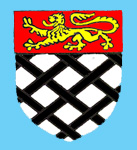The Manor of Polehanger

The Meppershall coat of arms
Volume II of The Victoria County History for Bedfordshire was published in 1908. The work gave detailed histories of every manor in the county. The authors proposd that the manor originated in a grant to the military order of the Knights Hospitaller of Saint John of Jerusalem by Henry III (1216-1272) in 1258. In 1335 the manor was held as tenants by Thomas, son of John de Meryng and Idonia, his wife. By 1361 the manor, described as a messuage and 18 acres of land was held by John de Meppershall from the overlords, the Knights Hospitaller. The Butler family also held land in Meppershall from the Knights and Joan de Meppershall married John Butler, the latter family holding Polehanger Manor from the Knights in 1482 when John Butler died.
The estate was divided between his two daughters, Joan and Florence. It is not known what happened to Florence, but the whole estate is later found in the sole possession of Joan Butler. Joan married twice. First to John Leventhorpe junior, and second to John Stanford. On her death in 1489, the manor passed to her surviving husband Stanford, 'for his life as tenant by courtesy'. On his death, it then passed to Joan's heir and son by her first husband, Thomas Leventhorpe.

The Leventhorpe coat of arms
The manor then passes down the Leventhorpe line until Thomas' great-grandson, also Thomas, died in 1620. As his only issue was his four year old daughter Elizabeth. By 1627 the manor was in the hands of Elizabeth's uncle Richard Stringer who alienated it to William Parsell. His widow and daughters alienated it to Robert Lovett in 1649.
The manor is then absent from the historical record until 1731 when it was held by John Compton or Crompton, who conveyed it in that year to George, Viscount Torrington and Pattee Byng. By 1805 the manor was held by Sir George Osborn of Chicksands Priory. By the 20th century, when manors were abolished in all but name it was held by Sir Algernon Kerr Butler Osborn. Today's Polehanger Farm must stand on or near the site of the original manor buildings